The pop culture ramblings of a Political Science Masters student. Twitter and Instagram: @_Hantaa
Last active 2 hours ago
Don't wanna be here? Send us removal request.
Text
After postponing it, I decided not to do a blog post this past week.
I’ve got a lot I’m preparing for, and I plan on making a post about it this Monday.
Stay tuned.
0 notes
Text
Don’t Listen to the Nay-Sayers, I’ve Got a Love for Pokemon Sword/Shield
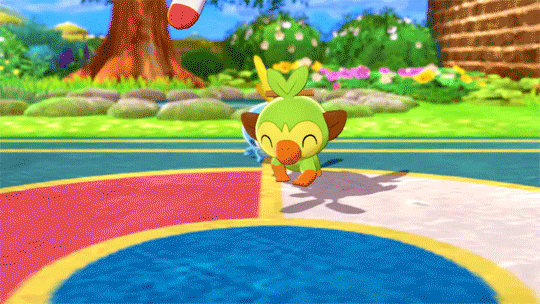
As I was trying to figure out something to post about this week, I was also trying to get a Grookey egg for a friend. That turned into me getting off the computer, laying down, and just playing Pokemon Shield. It may have been a good idea: not only did I hatch a shiny Grookey for myself after only 21 eggs as well as found a shiny Gigantamax Hatterene online, but I also found something I wanted to write about.
DISCLAIMER: I wrote this the day before the Direct came out talking about the new Expansions, so those will not be discussed in this write-up.
I’m presenting at the Pop Culture Association’s National Conference in April, with my topic being about how Pokemon’s fanbase refuses to evolve alongside the games. My research over winter break from school was supposed to be playing through all 8 gens of games, but I keep finding myself just playing Pokemon Shield. It may just be because I’m procrastinating, but I have Pokemon Red up on my 3DS just sleeping while I’m actively playing Pokemon Shield. Sorry Charmander, but the Galarian region is calling to me.
Before I got Pokemon Shield, I was one of the people who was in disbelief over what was deemed “Dex-It,” a term given to the fact that not all previous Pokemon would enter the region of Galar. Even more soured on the Pokemon Sword/Shield hype train, once reviews for Sword/Shield came out giving the game extreme praise, I began having almost resentment towards the title. How could a game with half the Pokemon and graphics looking like they came out of a Nintendo 64 rank better on IGN than any game since Black 2/White 2 (including the infamous Omega Ruby/Alpha Sapphire “7.8 - too much water” ranking)?
Regardless, I decided that I wanted it near release, and it’d be unfair of me to judge a game based on what people said rather than what I felt about it. The weekend that Pokemon Sword/Shield came out, I worked Friday and then doubles on Saturday and Sunday so that I could use the tip money that I accumulated towards Pokemon Shield. That Sunday, I walked over to my local Gamestop and picked up my copy, took it home, and started up the game. I was so exhausted that I only got to the starter selection portion of the game before falling asleep, but once I had my energy back, I went to work with my Pokemon buddies.

I almost always choose the Grass starter (except for lieking Mudkips in Gen 3), so Grookey was a natural choice for me. Besides, just look at that face. How could I NOT choose Grookey? Something that Pokemon Sword/Shield did better than any Pokemon game before it though is giving each and every starter a distinct personality. When Leon (the champion of the Galar region and your rival Hop’s brother) sends out the three Pokemon for you to select between, you’re treated to a cutscene of Grookey, Scorbunny, and Sobble interacting with one another. My heartstrings were tugged as I chose Grookey and Hop chose Sobble, leaving Scorbunny all alone. Leon assured Scorbunny that it could come with him and Charizard though, and I found myself elated that all three starters had homes. I hadn’t even had a Pokemon battle yet, and I was already invested in what would happen to the three starters in the game.
Hop won’t be the only rival you encounter throughout the game though, as many trainers are looking to advance in the challenge to become Pokemon Master. Marnie, alongside her faithful Morpeko, is also fighting to be the best like no one ever was. Cheering her on are Team Yell, which take on the roles of redeemable baddies much like Team Skull of Sun/Moon rather than outright baddies like Team Rocket. Both Marnie as well as Team Yell favor Dark type Pokemon, with the new Galarian form of Zigzagoon being a favorite of Team Yell. While Marnie has a competitive nature, she never is outright rude to the player, making her a more favorable rival to encounter during your journey. Contrasting Dark type trainer Marnie and her helpful attitude is Bede, a pastel trainer with a bad attitude who favors Psychic and Fairy types. While his interior is cold and ruthless, his relationships with Chairman Rose and Gym Leader Opal make him more endearing as the game goes on. Each rival you encounter has a satisfying end to their journey, showing that even if you don’t achieve your dream of becoming Pokemon Master, you can achieve a different dream.
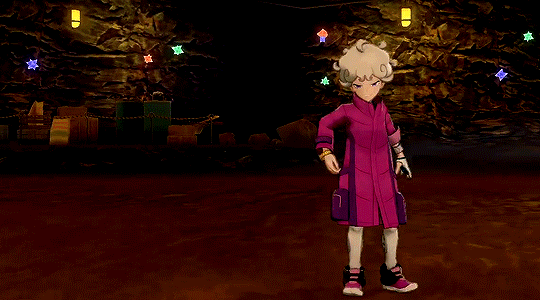
I don’t want to spoil the story for anyone reading this who hasn’t played Pokemon Sword/Shield yet, but I would venture to say that it’s the best story out of any game in recent memory. Of course, it follows the routine of start your journey, earn badges, challenge the champion, become Pokemon Master, but there are many surprises alongside the way. Just when I thought the game was over, a few hours of more content strung itself along before I was able to claim my title of Pokemon Master and beat up Leon’s Charizard.
I’m not sure how other people play the game, but the Pokemon Camp feature of the game really connected me to the Pokemon that I had in my party along the way. It’s similar to the Pokemon Amie and such of yesteryear, but with a few changes. Your Pokemon can actually interact with one another, for starters. My Pokemon would chat with each other, race against each other, and sometimes even fight each other (which I had to break up). You can create curry dishes for them, and they joyfully gobble up your food if you cook it well enough. Seriously, one of my favorite parts of the 125+ hours I’ve put into the game so far was when after cooking curry, a stray Hippopotas came to my camp and wanted to be in my party, alongside a ribbon he received for being a Curry Connoisseur. I gave him competitive stats and an Everstone, and I named him Roux after his love for curry.

The main story itself only took me around 35 hours to complete, and the postgame only took a few more hours, but as I said above, I’ve put 125+ hours into the game thus far. One of the reasons for this is the Wild Area, which is a welcome addition to the game for people who like exploration. After you’re thrown into the Wild Area, you learn after a period of time which areas you’re supposed to be in and which ones you need to get out of as soon as possible. Rather than having a sign saying DON’T GO HERE, you’ll encounter Pokemon impossible to beat. I myself used Pokedolls for the first time ever in a Pokemon game to allow myself to get away from Pokemon who were 20+ levels above me just so that my team wouldn’t black out.
My only critique of the Wild Area is that there are admittedly portions of it that look as though they came out of a Nintendo 64 game, specifically the graphics of the trees in the game. Before a friend got the game, I walked up to one of the berry trees and showed him how they would become see-thru and comprise of green dots where the treetops were supposed to be. We both laughed at how bad it looked. However, as bad as these graphical errors are, they never took away from my enjoyment of the game.
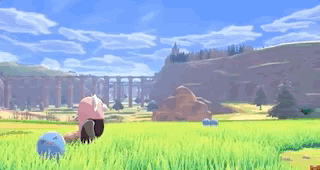
As a competitive player, I like how much simpler it is in the game to make your Pokemon in fighting shape. Instead of every single Pokemon having to be products of Daycare Eugenics, you’re able to use readily available berries to reset your Pokemon’s EVs, give them purchasable vitamins to give them desired EVs, use Bottle Caps to max out IVs, and even use new mechanics found in Mints to change the nature of your Pokemon to something viable. I was able to take the Grookey that I started the game with and make him competitive just using the post-game mechanics available. This also makes it so that you can use the shiny Pokemon that you find, rather than hoping and praying that you get the exact stats you want for one. My original Grookey-turned-Rillaboom, Lucio, is able to compete alongside his daughter, shiny Grookey-turned Rillaboom, Lucia.
I have a love/hate relationship with the online play in Pokemon Sword/Shield though, which could be attributed to how online play works in any Switch game period. I’ve grown to enjoy joining Pokemon Raids with people online, but I hate how you basically have to be actively trading to find any new Raids, especially with how frequently Raids fill up. I’ve got a box filled with baby Grookeys to mystery trade to people while I wait to battle Gigantamax Pokemon and eventually curse to myself while throwing out a Pokeball and failing to capture it. The trade off for the wait rarely pays off.
For my criticism of online play and the graphics of Pokemon Sword/Shield though, there’s so much more to appreciate about the game than that. I don’t know if I’d throw out “best Pokemon game ever,” but I definitely agree that it’s the best Pokemon game since Black 2/White 2. Damn you IGN for having me agree with you.
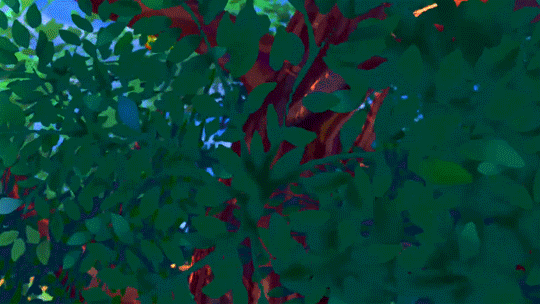
If any of you reading this happen to be interested in my future presentation of Pokemon info at the 2020 Pop Culture Association National Conference, be sure to watch out for future info. I’ll let y’all know when I’m presenting the closer it is.
4 notes
·
View notes
Text
Guess Who Write Tonight’s Show?: Space Ghost Coast to Coast and a History of Stopping (or Starting) the Insanity

Hands down, I can attribute my sense of humor and possibly my love for pop culture in general to the Cartoon Network-to-Adult Swim television show Space Ghost Coast to Coast. I’m not sure if it’s due to the nostalgia I had towards the show, or if it’s just because it’s so damn funny, but SGC2C is a show that I could watch on repeat and never get bored of, and I get bored of things pretty easily. As a kid, I remember Cartoon Network not being available on every cable package like it is today, so pretty much the only time I would get to watch it was during weekend stays at my grandparents’ house. I’d sit in the downstairs area and play with my Legos, staying up way too late, and watch shows like O’ Canada (a show that was comprised of Canadian produced shorts), Cartoon Planet (another show featuring the Space Ghost crew), and of course, Space Ghost Coast to Coast. As I got older and Cartoon Network was more readily available, Space Ghost Coast to Coast went from Cartoon Network to Adult Swim, and my parents forbade me from watching anything during the adult-only programming block (although I do remember sneaking and watching Aqua Teen Hunger Force episode “Mayhem of the Mooninites”). Once I got to middle school, while I couldn’t stay up late when Adult Swim was on, I received the first seasons of Aqua Teen Hunger Force and Space Ghost Coast to Coast on DVD. My friends would talk about Adult Swim, and I’d try to insert jokes from Space Ghost, and they’d respond “Oh we don’t watch that, we watch Family Guy.” Even though I started watching Family Guy to fit in, I found myself more drawn to the absurdity that was Space Ghost Coast to Coast.
Apparently, I wasn’t the only only one who didn’t have Cartoon Network in their home. It has been stated by the creators of Space Ghost Coast to Coast that during the beginning, they would watch the episodes at the office because none of them had Cartoon Network at home. The series was produced because Cartoon Network, a network originally comprising of archived cartoons, was wanting to produce original content for as cheap as possible. They wanted it to also appeal to adult viewers, with the idea that the market hadn’t yet appealed to this market. This became a reality by using footage and content from previous Hanna-Barbera series Space Ghost and inserting it over new backgrounds and imposing interviews over that. Matt Maiellaro, Andy Merrill, Khaki Jones, and Keith Crofford all wrote the earliest episodes while Mike Lazzo headed the program and Michael Cahill edited it. All of these people would be instrumental in the future Adult Swim block, but they got their first big start with Space Ghost Coast to Coast.
The premise of Space Ghost Coast to Coast is simple to explain, but things in the show never turn out to be as they should. Space Ghost interviews the guest, Zorak plays the music and antagonistically bounces off what Space Ghost says, and Moltar attempts to direct the show. At the beginning of the series, the show stays true to theme while placing various jokes within the shows. The first episode created, “Elevator,” sticks to having Space Ghost interview funny lady Judy Tenuta, my ex’s guide to taking shrooms Timothy Leary, and lover of baking chocolate pies Ashley Judd. You’d see hints to deviation in early episodes like in the first episode aired “Spanish Translation” where the cast’s proclamations would periodically be translated to Spanish and a faux evil nursery rhyme album starring Zorak and Moltar was advertised, or in “Batmantis” where Moltar had been kidnapped and Space Ghost attempted to have stars from the Batman television show help out Zorak’s alter ego Batmantis, but for the most part Space Ghost Coast to Coast operated in that there would be guests and comedic moments came from the interviews. It’s been said that the second season’s episode “Fire Drill” (which features an intro with Space Ghost complaining about sending gift baskets to Cartoon Network, created from simply taking voice actor George Lowe’s rantings from the voice booth) is when Space Ghost Coast to Coast’s premise took shape: making a comedic cartoon where interviews are taking place that becomes pure insanity.
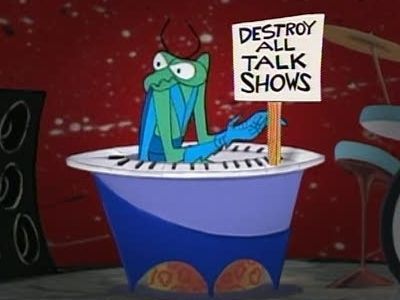
While adult animation and humor was hardly new in the 90s with shows like The Simpsons and South Park being mega hits, Space Ghost Coast to Coast pushed the boundaries unlike any other program. The earliest example of this in my estimation would be the episode “Transcript,” in which the show deviates from its editing of interviews to present the interview with musician Jonathan Richman almost word-for-word how the interview actually went. The episode that aired a week after, “Sharrock,” was simply an episode that played the musical stylings of departed Sonny Sharrock, with the guest being Thurston Moore of Sonic Youth posing as a guest named Fred Cracklin. One of my favorite episodes of the series is entitled “Pavement,” named after the band who performs during the episode. The episode’s premise was that Space Ghost had written the show himself so it becomes more and more outrageous as the episode goes on (an example is Space Ghost promising that The Beatles would replace Zorak as the musicians of the show, only for Pavement to show up with Space Ghost claiming that they’re The Beatles because the people watching the show are too stupid to know the difference), but the story of the episode behind the scenes was that periodically the writers would just pass around the script after a few minutes had passed and had to continue the story that had already been written.
The longer the series was on the air, the more and more they tried to push the boundaries of comedy, with the fifth season of the show introducing several episodes like this. The winners of the Haiku In For Space Ghost contest ran by Cartoon Network got to be interviewed for the show and appear on an episode of Space Ghost, only for their episode (entitled “Joshua”) to be a long parody of a corporate instructional video with the interviews being presented in the last minute of the episode. “Warren” was an episode that’s ending was the exact same scene as the beginning, and when it originally aired it aired the episode three times in a row as a continuous loop of an episode, with the joke being the length of the episode. “Waiting for Edward” had an extended minute-or-so introduction that was simply a black screen with the word “Waiting” visible to the audience. These bits of anti-humor became the precedent for what was to be expected from Space Ghost Coast to Coast, as well as what was to be expected in the future Adult Swim block.
The sixth season had even more jokes based on this anti-humor movement. “Snatch” (written by the future creators of Sealab 2021, Adam Reed and Matt Thompson) advertised at the end of the airing that the ending would be sold at an eBay auction, with it being revealed in the future that the ending was simply a message with letter dancing around to a comedic tune and eventually spelling out “THE END?” “Curling Flower Space” was presented as the end of an episode supposedly named “Brilliant Number Three” with Jerry Springer being interviewed, only for the episode to be three different accounts of how a previous Sarah Jessica Parker interview played out. What may be the most outrageous display of special Space Ghost Coast to Coast humor would be the “Fire Ant” episode. A week before “Fire Ant” aired, an episode titled “Table Read” had aired on Cartoon Network, showing the voice actors rehearsing for the upcoming episode “Fire Ant.” That was it. Once “Fire Ant” aired, it was shown as a half hour episode, with the second part of the episode being over ten minutes of Space Ghost simply slowly following an ant to its home.
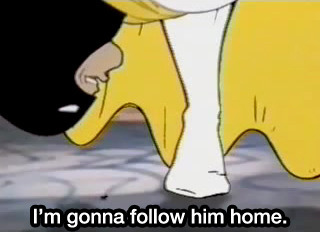
Almost two years later, Space Ghost Coast to Coast was moved from late night Cartoon Network to...well, still late night Cartoon Network, but a more edgy and adult late night Cartoon Network. Adult Swim, headed by the people instrumental over the years in making Space Ghost Coast to Coast, debuted in 2001 with shows similar to the Space Ghost Coast to Coast in that older Hanna-Barbera properties were taken and had new situations crafted for them. A more adult and edgy block seemed the perfect fit for Space Ghost Coast to Coast, but while a few curse words were added, the heart of the show remained the same. While only five episodes were created for season seven, eight episodes aired. This was thanks to “Kentucky Nightmare” being used three extra times in the form of the episode “Momentary” (an episode where the producers’ moms are providing commentary for “Kentucky Nightmare”), the episode “Momentary - Creator’s Commentary (an episode where the creators provide commentary for “Momentary”), and the episode “Momentary - Jellybean” (an episode where the creators just make a bunch of noise over “Momentary”). If it sounds crazy, that’s because it was crazy. But it was so crazy that it was hilarious.
Space Ghost Coast to Coast sadly didn’t receive many episodes in the Adult Swim era before ending (only 15 if you count the “Kentucky Nightmare”/”Momentary” rehashings), and its finale in true SGC2C fashion was promoted as an “Unfinished POS.” “Live at the Fillmore” is the only episode where not a single interview happens (the show has no budget, so Space Ghost suggests to interview the old Susan Powter interview from “Spanish Translation”), and as the episode continues it is obvious that it isn’t fully animated. The episode at the credits has no credits visible, and at the very end shows the credits for “Kentucky Nightmare.” The Adult Swim era of Space Ghost Coast to Coast ends where it begins. Sure, the series was revived later for website Gamefly and featured Space Ghost interviewing video game personalities, but the show that it was was dead and gone.

While Space Ghost Coast to Coast itself may be long gone, it has lived on in other Adult Swim programs. The Brak Show is a direct spinoff with Space Ghost appearing every now and then. Aqua Teen Hunger Force itself is a semi-spinoff of Space Ghost Coast to Coast, with the first idea for the team being seen in the SGC2C episode “Baffler Meal.” ATHF shows mention of its roots in both the episode “Carl Wash” in which the villains of the episode are Carl and Carl Jr. from SGC2C episode “Chambraigne,” and in the feature film where a missile launches and directly hits Space Ghost. Space Ghost cameos can be seen in every episode of Perfect Hair Forever, and in most episodes of Off the Air. A Robot Chicken sketch showed the counsel of Adult Swim being comprised of executives and included Space Ghost as a member of the counsel. While not directly tied, Eric Andre cites Space Ghost Coast to Coast as the influence for The Eric Andre Show. Various different advertisements over the years on Adult Swim have also featured Space Ghost interviewing a representative or mascot of a company.
Eric Andre has stated that Mike Lazzo is uninterested in ever bringing back Space Ghost Coast to Coast, and with the passing of C. Martin Croker (voice of Zorak and Moltar) in 2016, it seems as though a revival of the show is impossible. It’s a shame, as Space Ghost Coast to Coast is the grandfather of modern adult comedy in my opinion. Its redefinition of what comedy is and its forceful nature of making its viewers reconsider what is funny and what isn’t is the new standard of comedy. What made it a hidden gem during its length on television would make it a standout nowadays. When I think of something being beyond its time, Space Ghost Coast to Coast is a standout.
Should I be talking about a small cult classic like Space Ghost Coast to Coast as my first musing, something that several people reading this probably haven’t even watched? I believe it’s necessary to talk about Space Ghost Coast to Coast if I’m giving you a depiction of how I’m going to talk about things and why. I’ve been able to understand numerous cultural references and personalities thanks to the show (every time Carol Channing is referenced on Rupaul’s Drag Race my only point of reference to her is when she flirted with Space Ghost). The show has also taught me more about comedy than anything else, teaching me that the joke isn’t in what you say, but the context and how you say it. You all may not have heard of Space Ghost Coast to Coast before, but I thank it for the way I communicate and the way that I enjoy pop culture.
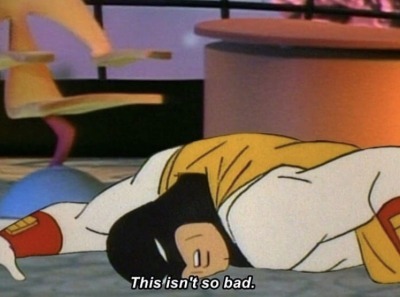
If you want to check out the show, it’s available almost entirely on adultswim.com for free now, and will be on the HBO Max platform when it launches in May 2020. The early episodes may be hard pills to swallow at first, but the roller coaster gets better and better the longer you ride it.
5 notes
·
View notes
Text
Welcome to my new blog. Are You Getting Enough Oxygen?
Named after the question Space Ghost always asked his guests on “Space Ghost Coast to Coast,” I decided to create a blog where I could give you all my musings on different pop culture stuff. I’m a grad student who typically focuses on the social and political effects that pop culture has, but not every idea I have warrants an academic paper or an in depth thesis. Sometimes I just want to shoot the shit, ya’ know? Expect me to post here about my thoughts and ideas on shows, movies, video games, and anything culture related.
Right now my plan is to post something at least once a week, 12pm on Fridays. As I said though, I’m a grad student, and I also work two jobs, so I may deviate from that schedule sometimes. Anything outside of that I’ll be sure to post about though.
Tomorrow I’ll be posting my first post here, talking about my favorite show of all time. Follow the blog so that you’ll be one of the first to see it.
Thanks y’all! -Hunter
1 note
·
View note